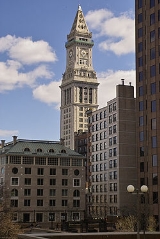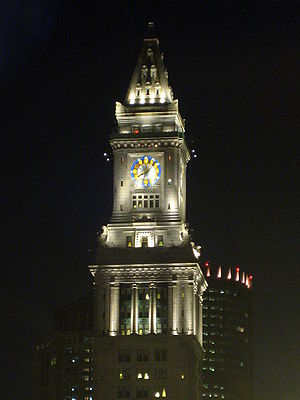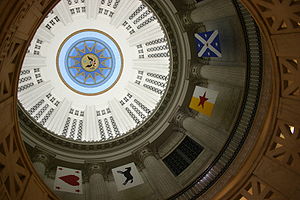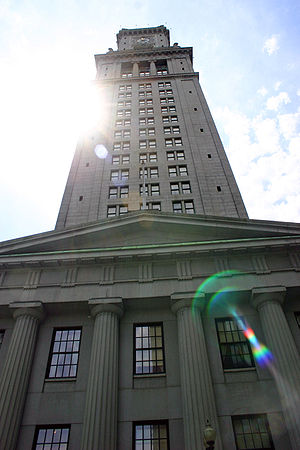
Custom House Tower
Encyclopedia
The Custom House Tower - now Marriott's Custom House Hotel - is a skyscraper
in McKinley Square, in the Financial District
neighborhood of Boston, Massachusetts
, in the United States
. Construction began in the mid-19th century; the tower was added in the 1910s. Standing at 496 feet (151 m) tall, the tower is currently Boston's 17th-tallest building.
The tower is part of the Custom House District
, added to the National Register of Historic Places
in 1973.
was authorized by U.S. President Andrew Jackson
. When it was completed in 1849, it cost about $1,076,000, in contemporary U.S. currency, including the site, foundations, etc.
Ammi Burnham Young
entered an 1837 competition to design the Boston Custom House, and won with his neoclassical
design. This building was a cruciform (cross-shaped) Greek Revival structure, combining a Greek
Doric
portico
with a Roman
dome
, resembled a four-faced Greek temple
topped with a dome. It had 36 fluted Doric column
s, each carved from a single piece of granite
from Quincy
, Massachusetts; each weighed 42 tons
(37 metric tons) and cost about $5,200. Only half these actually support the structure; the others are free-standing. They are 5 feet (1.5 m) and 4 inches (162 cm) in diameter and 32 feet (9.7 m) high. Inside, the rotunda
was capped with a skylight dome.
The entire structure sits on filled land and is supported by 3,000 wooden pile
s driven through fill to bedrock
. Before land reclamation was done in the mid-19th century, Boston's waterfront
extended right to this building. Ships moored at Long Wharf
almost touched the eastern face of the building. The Custom House was built at the end of the City docks, to facilitate inspection and registration of cargo. The federal government
used the building to collect maritime duties in the age of Boston clipper ships.
This description of the original Custom House appears in the 1850 Boston Almanac:




added the tower to the base. Although Boston at that time had a 125-foot (38-m) height restriction, the Custom House was federally owned and exempt from it. The new tower's 496 feet (151 m) made it the city's tallest. In 1947, the Old John Hancock Building
, just one foot shorter, joined it in the skies over Boston. In 1964, it was exceeded by the Prudential Tower
. The clock on the upper tower of the building is 22 feet (6.7 m) in diameter. Because of an undersized motor, it failed to work properly through much of the 20th century. In 1960, the Great Seal of the United States
was painted in the lobby's dome.
. The building remained unoccupied and inaccessible for 14 years. Working with the Boston Redevelopment Authority
, The Landmarks Commission and Massachusetts Historical Society, The Beal Companies and Jung/Brannen Associates, Inc. proposing concepts ranging from museums to offices to residential developments. In 1995, The Beal Companies and Marriott Ownership Resorts International announced plans to develop it into a time-share resort, with Jung Brannen Associates retained as Architects. It was converted into an 87-room Marriott Vacation Club starting in 1997.
One of the greatest challenges facing the design team was the limited square footage of usable space on each of the tower floors, and one of the primary reasons that redevelopment into modern use had posed such a problem. In order to transform the Custom House into a financially viable real estate asset for Marriott, the team had to maximize the size and number of suites that could be located in the building. Working around the tower’s structural constraints, the project team devised ways to fit four to five suites with custom-designed built-in cabinetry and furnishings, on each floor. This resulted in the creation of 87 one-bedroom suites with 22 different floorplan designs. A private owner’s lounge, an exercise area and a game room are a few of the other amenities designed into the project. Also designed into the project was significant public access: a new ground floor and rotunda-level maritime museum and exhibit space, and guided tours of the refurbished observation deck on the tower’s 26th floor.
Pressley Associates, Inc. is the landscape architecture that redesigned the front plaza in 1999 "It provides a new urban linkage space that provides a sense of cohesion between Custom House Tower, Faneuil Hall and Marketplace Center." "As part of the current rehabilitation of the Tower to hotel use, the mandate of the landscape architectural design was to unify and revitalize the urban environment while respecting the buildings' historical importance. A 1 acres (4,046.9 m²) plaza has been designed to encourage pedestrian access and use, and to relate contextually to the adjacent Faneuil Hall Markets and Marketplace Center through the extensive use of large caliper shade trees, brick and granite pavements, and high quality site furnishings. The scope of work provided includes site design, construction documents, approvals process, presentations, resident engineering and construction support services.
Skyscraper
A skyscraper is a tall, continuously habitable building of many stories, often designed for office and commercial use. There is no official definition or height above which a building may be classified as a skyscraper...
in McKinley Square, in the Financial District
Financial District, Boston, Massachusetts
The Financial District of Boston, Massachusetts, United States is located in the downtown area near Government Center and Chinatown.Like many areas within Boston, the Financial District has no official definition. It is roughly bounded by Atlantic Avenue, State Street, and Devonshire Street...
neighborhood of Boston, Massachusetts
Massachusetts
The Commonwealth of Massachusetts is a state in the New England region of the northeastern United States of America. It is bordered by Rhode Island and Connecticut to the south, New York to the west, and Vermont and New Hampshire to the north; at its east lies the Atlantic Ocean. As of the 2010...
, in the United States
United States
The United States of America is a federal constitutional republic comprising fifty states and a federal district...
. Construction began in the mid-19th century; the tower was added in the 1910s. Standing at 496 feet (151 m) tall, the tower is currently Boston's 17th-tallest building.
The tower is part of the Custom House District
Custom House District
Custom House District is a historic district in Boston, Massachusetts located between the Fitzgerald Expressway and Kirby Sreet and South Market and High and Batterymarch Streets...
, added to the National Register of Historic Places
National Register of Historic Places
The National Register of Historic Places is the United States government's official list of districts, sites, buildings, structures, and objects deemed worthy of preservation...
in 1973.
Original building
The site was purchased on September 13, 1837. Construction of a custom houseCustom House
A custom house or customs house was a building housing the offices for the government officials who processed the paperwork for the import and export of goods into and out of a country. Customs officials also collected customs duty on imported goods....
was authorized by U.S. President Andrew Jackson
Andrew Jackson
Andrew Jackson was the seventh President of the United States . Based in frontier Tennessee, Jackson was a politician and army general who defeated the Creek Indians at the Battle of Horseshoe Bend , and the British at the Battle of New Orleans...
. When it was completed in 1849, it cost about $1,076,000, in contemporary U.S. currency, including the site, foundations, etc.
Ammi Burnham Young
Ammi B. Young
Ammi Burnham Young was an important 19th century American architect whose commissions transitioned from the Greek Revival to the Neo-Renaissance styles. His Second Vermont State House brought him fame and success, which eventually led him to become the first Supervising Architect of the U.S....
entered an 1837 competition to design the Boston Custom House, and won with his neoclassical
Neoclassical architecture
Neoclassical architecture was an architectural style produced by the neoclassical movement that began in the mid-18th century, manifested both in its details as a reaction against the Rococo style of naturalistic ornament, and in its architectural formulas as an outgrowth of some classicizing...
design. This building was a cruciform (cross-shaped) Greek Revival structure, combining a Greek
Architecture of Ancient Greece
The architecture of Ancient Greece is the architecture produced by the Greek-speaking people whose culture flourished on the Greek mainland and Peloponnesus, the Aegean Islands, and in colonies in Asia Minor and Italy for a period from about 900 BC until the 1st century AD, with the earliest...
Doric
Doric order
The Doric order was one of the three orders or organizational systems of ancient Greek or classical architecture; the other two canonical orders were the Ionic and the Corinthian.-History:...
portico
Portico
A portico is a porch leading to the entrance of a building, or extended as a colonnade, with a roof structure over a walkway, supported by columns or enclosed by walls...
with a Roman
Roman architecture
Ancient Roman architecture adopted certain aspects of Ancient Greek architecture, creating a new architectural style. The Romans were indebted to their Etruscan neighbors and forefathers who supplied them with a wealth of knowledge essential for future architectural solutions, such as hydraulics...
dome
Dome
A dome is a structural element of architecture that resembles the hollow upper half of a sphere. Dome structures made of various materials have a long architectural lineage extending into prehistory....
, resembled a four-faced Greek temple
Greek temple
Greek temples were structures built to house deity statues within Greek sanctuaries in Greek paganism. The temples themselves did usually not directly serve a cult purpose, since the sacrifices and rituals dedicated to the respective deity took place outside them...
topped with a dome. It had 36 fluted Doric column
Column
A column or pillar in architecture and structural engineering is a vertical structural element that transmits, through compression, the weight of the structure above to other structural elements below. For the purpose of wind or earthquake engineering, columns may be designed to resist lateral forces...
s, each carved from a single piece of granite
Granite
Granite is a common and widely occurring type of intrusive, felsic, igneous rock. Granite usually has a medium- to coarse-grained texture. Occasionally some individual crystals are larger than the groundmass, in which case the texture is known as porphyritic. A granitic rock with a porphyritic...
from Quincy
Quincy, Massachusetts
Quincy is a city in Norfolk County, Massachusetts, United States. Its nicknames are "City of Presidents", "City of Legends", and "Birthplace of the American Dream". As a major part of Metropolitan Boston, Quincy is a member of Boston's Inner Core Committee for the Metropolitan Area Planning Council...
, Massachusetts; each weighed 42 tons
Short ton
The short ton is a unit of mass equal to . In the United States it is often called simply ton without distinguishing it from the metric ton or the long ton ; rather, the other two are specifically noted. There are, however, some U.S...
(37 metric tons) and cost about $5,200. Only half these actually support the structure; the others are free-standing. They are 5 feet (1.5 m) and 4 inches (162 cm) in diameter and 32 feet (9.7 m) high. Inside, the rotunda
Rotunda (architecture)
A rotunda is any building with a circular ground plan, sometimes covered by a dome. It can also refer to a round room within a building . The Pantheon in Rome is a famous rotunda. A Band Rotunda is a circular bandstand, usually with a dome...
was capped with a skylight dome.
The entire structure sits on filled land and is supported by 3,000 wooden pile
Deep foundation
A deep foundation is a type of foundation distinguished from shallow foundations by the depth they are embedded into the ground. There are many reasons a geotechnical engineer would recommend a deep foundation over a shallow foundation, but some of the common reasons are very large design loads, a...
s driven through fill to bedrock
Bedrock
In stratigraphy, bedrock is the native consolidated rock underlying the surface of a terrestrial planet, usually the Earth. Above the bedrock is usually an area of broken and weathered unconsolidated rock in the basal subsoil...
. Before land reclamation was done in the mid-19th century, Boston's waterfront
Dock (maritime)
A dock is a human-made structure or group of structures involved in the handling of boats or ships, usually on or close to a shore.However, the exact meaning varies among different variants of the English language...
extended right to this building. Ships moored at Long Wharf
Long Wharf (Boston)
Long Wharf in Boston, Massachusetts "was the busiest pier in the busiest port in America during early colonial times." It extended nearly a half-mile into the harbor, beginning from State Street...
almost touched the eastern face of the building. The Custom House was built at the end of the City docks, to facilitate inspection and registration of cargo. The federal government
Federal government of the United States
The federal government of the United States is the national government of the constitutional republic of fifty states that is the United States of America. The federal government comprises three distinct branches of government: a legislative, an executive and a judiciary. These branches and...
used the building to collect maritime duties in the age of Boston clipper ships.
This description of the original Custom House appears in the 1850 Boston Almanac:
- Situated at the head of the dock between Long and Central Wharves, fronts east on the dock, west on India Street, and is in the form of a Greek Cross, [with] the opposite sides and ends being alike. It is 140 feet (42.7 m) long north and south, 75 feet (22.9 m) wide at the ends, and 95 feet (29 m) through the centre. It is built on about 3,000 piles, fully secured against decay; the construction throughout is fireproof and of the very best kind.
- The exterior of the building is purely Grecian Doric, not a copy, but adapted to the exigencies and peculiarities of the structure, and consists of a portico [overhang] of 6 columns on each side, on a high flight of steps, and an order of engaged columns around the walls, 20 in number, on a high stybolate or basement; the order of engaged columns terminating with 4 andae [pilasters] at their intersection with the porticos. The columns are 5 in 4 in (1.63 m) in diameter and 32 feet (9.8 m) high, the shaft being in one place, each weighing about 42 tons.
- The cellar, which is 10 in 6 in (3.2 m) high to the crown of the arches, is principally used for the storage of goods, which are conveyed to it through the basement story. The steam apparatus for warming the whole building (which it does effectively) is situated in the cellar, having easy access to the coal vaults under the sidewalk outside of the building.
- The principal entrances to the basement story are at each end. They are for the receipt of goods for storage. Near the northwest corner, on the west side, is the entrance to the Night Inspectors' apartments, also to the private staircase leading to the Collector's room and the attic. South of the west portico is the entrance to the heating apparatus room, and on the south end is the entrance to the Custom House Truckmen's room. This story consists of rooms for the Night Inspectors, Custom House Truckmen, and Engineer of the Heating Apparatus, also three sets of Water Closets: the remainder is used for storage of goods, weigher's tabs, etc.




- The principal ingress to the entrance story is through the porticos, but it can be entered from the Collector's private staircase, and from two other private staircases in the basement. This story contains apartments and offices for the Assistant Treasurer, the Weighers and Gaugers, the Measurers, Inspectors, Markers, Superintendent of Building, etc. In the centre is a large vestibule, from which two broad flights of steps lead to the principal story, landing in two smaller vestibules therein, lighted by skylights in the roof, and these vestibules communicate with all the apartments in this story. The several rooms are for the Collector, Assistant Collector, Naval Officer, Surveyor, Public Store Keeper, their Deputies and Clerks; and for the facilities of doing business this arrangement is not surpassed. The grand-cross shaped Rotunda, for the general business of the Collector's department, in the centre of this story, is finished in the Grecian Corinthian order; it is 63 feet (19.2 m) in its greatest length, 59 feet wide, and 62 feet (18.9 m) in the skylight.
- In one of the panels of the Rotunda is inserted a tablet of marble (Dedication Tablet 1847), containing the following inscription: Boston Custom House Building. Authorized by the 23d Congress, A.D. 1835. Andrew Jackson, President U.S.A.; Levi Woodbury, Sec'y of the Treasury.—Opened August 1st, A.D. 1847, James K. Polk, President U.S.A.; Robert J. Walker Sec'y of the Treasury; Marcus Morton, Collector of the Port; Samuel S. Lewis, Robert G. Shaw, Commissioners; Ammi Burnham Young, Architect.
Tower
By 1905, increased shipping required the building's expansion. In 1913–1915, the architecture firm Peabody and StearnsPeabody and Stearns
Peabody & Stearns was a premier architectural firm in the Eastern United States in the late 19th century and early 20th century. Based in Boston, Massachusetts, the firm consisted of Robert Swain Peabody and John Goddard Stearns, Jr...
added the tower to the base. Although Boston at that time had a 125-foot (38-m) height restriction, the Custom House was federally owned and exempt from it. The new tower's 496 feet (151 m) made it the city's tallest. In 1947, the Old John Hancock Building
Berkeley Building
The Berkeley Building is a 36-story, structure located at 200 Berkeley Street, Boston, Massachusetts, USA. It is the second of the three John Hancock buildings built in Boston; it was succeeded by the John Hancock Tower. The building is known for the weather beacon at its summit, which...
, just one foot shorter, joined it in the skies over Boston. In 1964, it was exceeded by the Prudential Tower
Prudential Tower
The Prudential Tower, also known as the Prudential Building or, colloquially, The Pru, is a skyscraper in Boston, Massachusetts. The building, a part of the Prudential Center complex, currently stands as the 2nd-tallest building in Boston, behind the John Hancock Tower. The Prudential Tower was...
. The clock on the upper tower of the building is 22 feet (6.7 m) in diameter. Because of an undersized motor, it failed to work properly through much of the 20th century. In 1960, the Great Seal of the United States
Great Seal of the United States
The Great Seal of the United States is used to authenticate certain documents issued by the United States federal government. The phrase is used both for the physical seal itself , and more generally for the design impressed upon it...
was painted in the lobby's dome.
Current use
When custom officials moved to the Thomas P. O'Neill building in 1986, the Custom House was declared "surplus property". On April 16, 1987, the city of Boston purchased the building from the General Services AdministrationGeneral Services Administration
The General Services Administration is an independent agency of the United States government, established in 1949 to help manage and support the basic functioning of federal agencies. The GSA supplies products and communications for U.S...
. The building remained unoccupied and inaccessible for 14 years. Working with the Boston Redevelopment Authority
Boston Redevelopment Authority
The Boston Redevelopment Authority is the municipal planning and development agency for Boston, working on both housing and commercial developments.The BRA was established by the Boston city council and the Massachusetts legislature in 1957...
, The Landmarks Commission and Massachusetts Historical Society, The Beal Companies and Jung/Brannen Associates, Inc. proposing concepts ranging from museums to offices to residential developments. In 1995, The Beal Companies and Marriott Ownership Resorts International announced plans to develop it into a time-share resort, with Jung Brannen Associates retained as Architects. It was converted into an 87-room Marriott Vacation Club starting in 1997.
One of the greatest challenges facing the design team was the limited square footage of usable space on each of the tower floors, and one of the primary reasons that redevelopment into modern use had posed such a problem. In order to transform the Custom House into a financially viable real estate asset for Marriott, the team had to maximize the size and number of suites that could be located in the building. Working around the tower’s structural constraints, the project team devised ways to fit four to five suites with custom-designed built-in cabinetry and furnishings, on each floor. This resulted in the creation of 87 one-bedroom suites with 22 different floorplan designs. A private owner’s lounge, an exercise area and a game room are a few of the other amenities designed into the project. Also designed into the project was significant public access: a new ground floor and rotunda-level maritime museum and exhibit space, and guided tours of the refurbished observation deck on the tower’s 26th floor.
Pressley Associates, Inc. is the landscape architecture that redesigned the front plaza in 1999 "It provides a new urban linkage space that provides a sense of cohesion between Custom House Tower, Faneuil Hall and Marketplace Center." "As part of the current rehabilitation of the Tower to hotel use, the mandate of the landscape architectural design was to unify and revitalize the urban environment while respecting the buildings' historical importance. A 1 acres (4,046.9 m²) plaza has been designed to encourage pedestrian access and use, and to relate contextually to the adjacent Faneuil Hall Markets and Marketplace Center through the extensive use of large caliper shade trees, brick and granite pavements, and high quality site furnishings. The scope of work provided includes site design, construction documents, approvals process, presentations, resident engineering and construction support services.
See also
- Boston Custom HouseBoston Custom HouseThe Custom House in Boston, Massachusetts, was established in the 17th century and stood near the waterfront in several successive locations through the years. In 1849 the U.S. federal government constructed a neoclassical building on State Street; it remains the "Custom House" known to Bostonians...
- Custom House DistrictCustom House DistrictCustom House District is a historic district in Boston, Massachusetts located between the Fitzgerald Expressway and Kirby Sreet and South Market and High and Batterymarch Streets...
- List of tallest buildings in Boston

